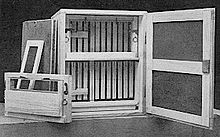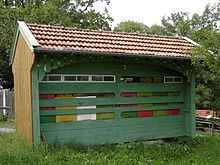Aftertreatment prey


The aftertreatment hive , also known as the leaf hive , is one of the artificially made dwellings of honey bees used in beekeeping , the so-called bee hives . Its design is similar to a small cupboard and, in contrast to today's widespread magazine loot, is not operated from above, but from the rear.
Behind treatment Booty found earlier great use in the field of beekeeping with bee hives and stands , which until its demise in the 1970s, mainly in German-speaking countries were widespread, and in the transhumance with bee car (traveling carriages). As a result of the increased occurrence of the magazine hive, which has usually always been used in other countries, beehives and wagons and thus also the hives for post-treatment were superfluous. The GDR was an exception , where up until German reunification in 1990 there were almost exclusively apiaries and beehives. Today, hives with back treatment are hardly to be found.
The main advantage of this type of hive is its ease of use. Where frames have to be laboriously stacked with magazine hives, all levels of the beehive are directly accessible with rear treatment hives . Several bee colonies can also be stacked on top of one another without difficulty, without making access difficult. These compact hives can therefore sometimes still be found on wagons.
The disadvantages of the aftertreatment hive are primarily its inflexibility. The space is fixed, and so it can happen that the people “grow out” of the prey. Furthermore, all honeycombs have to be removed individually for the honey harvest , whereas with magazine hives the complete frames of the honey chamber can simply be removed. The spatial restriction is the main reason for their decline and the switch to modern magazine hive.
literature
- Karl-Heinz Vanicek: Beekeeping expertise. VEB Deutscher Landwirtschaftsverlag (DLV), Berlin 1966, DNB 457054344 , pp. 141–147.
Individual evidence
- ↑ See: Kurt Vieweg , Otto Rosenkranz (Ed.): Tierische Produktion (= Handbook of Cooperative Farmers , Volume 3). German Academy of Agricultural Sciences , Berlin 1954, DNB 366091530 , p. 240 ff.
- ↑ a b c See technical article: The magazine stick - the beginning of a new era. In: World of bees. The specialist journal for contemporary beekeepers , Leopold Stocker Verlag , Graz, 1984, issue No. 26–28, ISSN 0006-2146 , p. 57 ff.